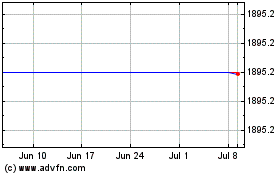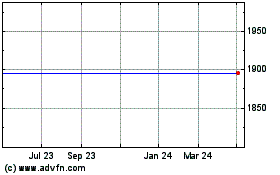By Valerie Bauerlein, Rebecca Elliott and Elizabeth Findell
BEAUMONT, Texas -- Hurricane Laura barreled toward the Texas and
Louisiana coasts late Wednesday as a vicious Category 4 storm
nearing Category 5, threatening what forecasters described as
lethal flooding and widespread wind damage.
Laura was poised to strike the heart of U.S. fuel-making and
chemicals production, much of which is located in low-lying areas
along the Gulf Coast. Nearly half of the nation's refining capacity
is on the Gulf Coast, federal data show, with about half of that
within Laura's potential path, analytics firm IHS Markit said.
Refineries, chemical plants and ports closed in preparation for
the hurricane's arrival, including Saudi Arabian Oil Co.'s Motiva
refinery, the nation's largest fuel-making facility.
The fast-moving hurricane continued to gain strength Wednesday
evening, with sustained winds of 150 miles an hour, according to
the 8 p.m. ET update from the National Hurricane Center, and it
could still strengthen before it makes landfall. It is close to the
157 mile an hour threshold of a Category 5 storm. Hurricane-force
winds extended 60 miles outward, the center said.
Tropical-storm-force winds were beginning to hit parts of
Louisiana on Wednesday evening. Laura is projected to make landfall
early Thursday
Laura is a storm of historic proportions, with wind speed at
landfall on track to surpass Hurricane Katrina in 2005, which made
landfall near New Orleans as a Category 3 storm. While the western
Gulf Coast is less densely populated than the New Orleans area,
Laura, like Katrina, is expected to make landfall in the dead of
night, complicating any last-minute evacuation or rescue
efforts.
Laura is expected to produce waves as high as 20 feet along
portions of the Louisiana coast, with as much as 15 inches of
rainfall. The city of Lake Charles, La., braced for as much as 15
feet of flooding, far more than the 8 feet that constitute a major
flood in a low-lying area.
TV crews abandoned coastal stations, as did meteorologists with
the National Weather Service's local forecasting office.
For Beaumont, a Texas city of about 116,000 people, evacuation
orders left it a ghost town, with boarded-up businesses and empty
streets. Some were still scrambling to leave Wednesday evening.
Arthur Richardson, 63 years old, said he had planned to ride out
the storm, as he had during previous hurricanes, but its increasing
intensity left him spooked. He decided late Wednesday afternoon to
evacuate to Houston.
"When Ike was here, the whoopin' we took, it looked like it was
gonna come in through the house," he said of the 2008 hurricane. "I
don't want to go through that again."
But Mr. Richardson's neighbor Joan Holmes, 73, who lives with
her Chihuahua, Jody, said the previous storms hadn't scared her.
She will stay for this one too. She has nowhere else to go and is
afraid to drive alone, she said. Another neighbor across the street
who is also staying, Edgar Salazar, 38, called out to her to come
over if things got bad.
President Trump said his administration was working with state
and local governments to help the people of Texas and Louisiana, as
well as those in Arkansas, where winds and rain are expected to
cause flooding, topple trees and down power lines.
"Listen to local officials," he said in a tweet. "We are with
you!"
Forecasters warned of large and destructive waves that could
cause catastrophic damage from Sea Rim State Park in Texas to
Intracoastal City along the Gulf Intracoastal Waterway in
Louisiana. The storm surge could reach as far as 30 miles inland,
backing up rivers and producing dangerous flooding.
Officials in Texas and Louisiana issued mandatory evacuation
orders in more than a dozen coastal cities and counties from Grand
Isle, La., to Galveston, Texas, affecting hundreds of thousands of
people. Voluntary evacuation orders were in place in numerous other
jurisdictions.
Laura was moving at 15 miles an hour, far faster than storms
including 2018's plodding Hurricane Florence, which allowed time
for extensive planning.
The Covid-19 pandemic complicated Wednesday's last-minute
preparation. Officials adapted shelters with distancing measures
and masks to accommodate those fleeing as the coronavirus continues
to grip both states.
In Austin, Texas, evacuees were tested for Covid-19 as they
checked into shelters. In Lake Charles, residents fleeing the town
by bus were required to wear masks and maintain social
distance.
Louisiana Gov. John Bel Edwards said the government booked
hundreds of hotel rooms to house evacuees, to avoid crowding
traditional shelters.
Texas Gov. Greg Abbott warned residents of coastal southeastern
Texas on Wednesday afternoon that they had only a few hours to
evacuate before the onset of heavy winds.
"We urge everybody who may be in harm's way to take these few
last hours to get out of harm's way," he said. "Because of the
power of this storm, if you are unable, or do not get out of harm's
way, the reality is for almost a 24-hour time period, there will be
no ability for [rescuers] to get in and assist you in any way."
Hurricane Laura intensified rapidly early Wednesday, fueled by
warm water in the Gulf of Mexico and unimpeded by winds that could
disrupt it. The storm is fast-moving, large and well-defined, said
Ken Graham, director of the National Hurricane Center, in a
Wednesday video briefing.
At 5 p.m. Wednesday, the hurricane's center was about 155 miles
southeast of Port Arthur, Texas, and Lake Charles, La.
More than 430,000 homes in Texas and Louisiana, with a
reconstruction cost value of $88.6 billion, are at risk of
storm-surge damage, according to an analysis by CoreLogic Inc., a
financial and property data firm.
Mr. Edwards said that the impact from the storm's powerful winds
would be stronger than officials initially believed and that all of
coastal Louisiana should brace for storm surge. He likened the
storm to Hurricane Rita in 2005, which followed a path similar to
Laura's, damaging or destroying thousands of homes and inundating
coastal communities.
For the nation's oil industry, the risk is considered
serious.
Companies had shut down some 84% of oil production in the Gulf
of Mexico as of Wednesday, according to the U.S. Bureau of Safety
and Environmental Enforcement, amounting to about 1.6 million
barrels a day or roughly 15% of U.S. oil output.
Even facilities located outside the hurricane's central path
braced for possible impacts, sending nonessential personnel home.
Campuses were cleaned up to prevent stray items from becoming
projectiles in high winds.
Royal Dutch Shell PLC was continuing to operate refining and
chemicals facilities in the New Orleans area, where safety manager
Martin Padilla was closely monitoring the hurricane's route.
"Any little shift in that track and that puts us potentially
closer to tropical- storm-force winds," Mr. Padilla said.
Laura comes fairly early in what has already been an active
hurricane season, which stretches from June through November. It is
rare for a storm to make landfall in the Gulf Coast as a Category 4
storm.
Phil Klotzbach, a hurricane specialist at Colorado State
University, said that Laura is now the strongest August hurricane
in the Gulf of Mexico since Katrina and a historically fierce one.
"No Category 4-5 hurricanes have made landfall in extreme eastern
Texas or southwest Louisiana on record," since 1851, when record
keeping began, he said.
The National Oceanic and Atmospheric Administration said this
season it expects to see as many as 10 hurricanes -- of which three
to six are expected to be rated a major hurricane of Category 3 or
higher. The prediction is based on warmer ocean temperatures and
weaker trade winds in the main storm development region of the
tropical Atlantic and Caribbean Sea, forecasters have said.
Write to Valerie Bauerlein at valerie.bauerlein@wsj.com, Rebecca
Elliott at rebecca.elliott@wsj.com and Elizabeth Findell at
Elizabeth.Findell@wsj.com
(END) Dow Jones Newswires
August 26, 2020 22:15 ET (02:15 GMT)
Copyright (c) 2020 Dow Jones & Company, Inc.
Shell (LSE:RDSA)
Historical Stock Chart
From Mar 2024 to Apr 2024

Shell (LSE:RDSA)
Historical Stock Chart
From Apr 2023 to Apr 2024
